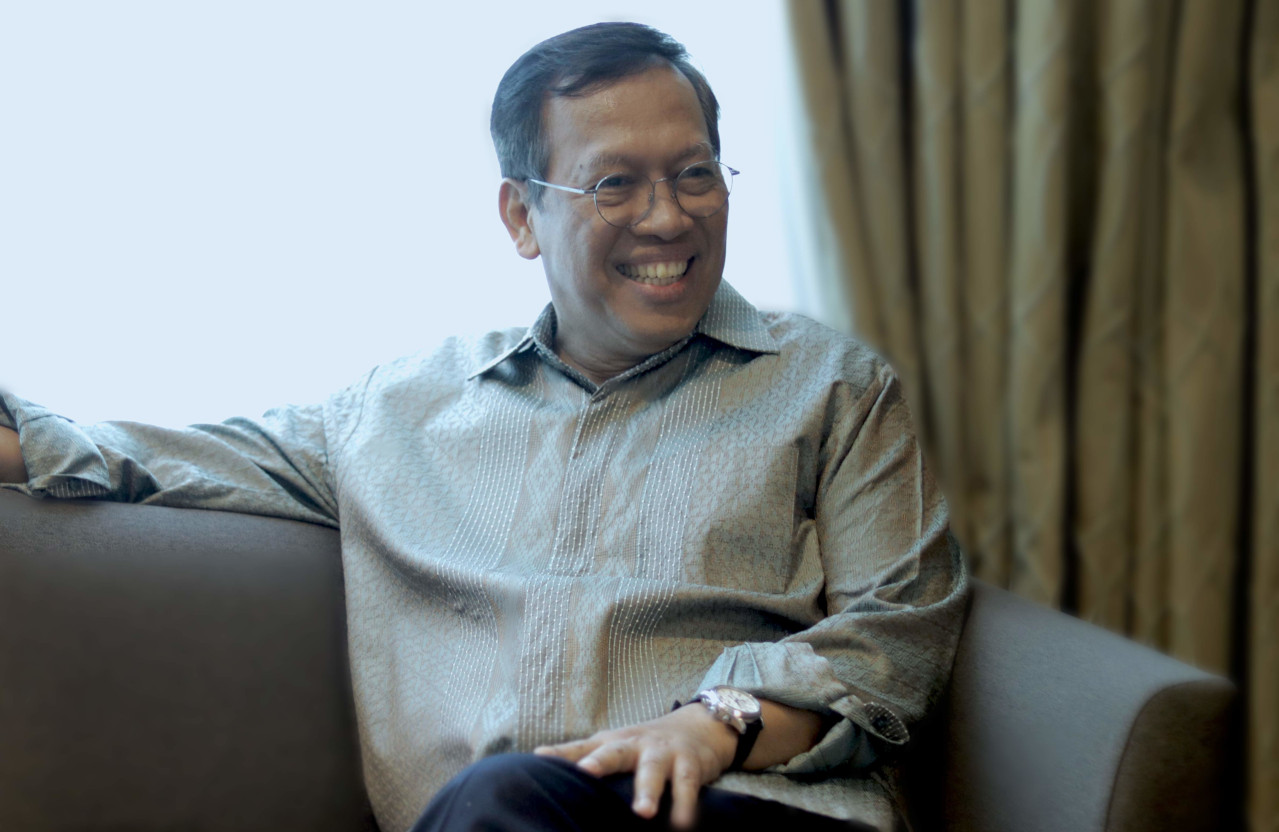Reckoning Reform Direction & Tax Resolution under Robert Pakpahan’s Control
Monday, 01 January 2018

Approaching 2017 New Year’s Eve, Directorate General of Taxes (DGT) has a new director, who is actually a senior figure in the institution. He is Robert Pakpahan, the ex-Director General of Budget Financing and Risk Management, who was formerly serving as a fiscal authority in the DGT for more than three decades (35 years). Robert was called to return to the DGT by the Minister of Finance Sri Mulyani Indrawati to take the vacant position left by Ken Dwijugisteadi following his retirement.
A pile of “homework” has been waiting for Robert. Other than ensuring that the tax revenue in the upcoming years is secure (reaching the target), he is also urged to lead the DGT’s soft landing at the end of 2017. It is conducted by minimizing the potential of tax shortfall or at least preventing the increase of state budget’s deficit from becoming too high, instead of reaching the tax target in the Amendment of State Budget and Expenditure (Anggaran Pendapatan Belanja Negara Perubahan/APBNP) 2017 that is impossible to reach in the remaining 1 (one) month.
Moreover, Robert also has other important tasks, other than tax revenue that always misses the target. The Minister of Finance in the inauguration speech pointed to Robert that the DGT should maintain the situation of investment and economic activities to remain conducive. In principle, tax policy should not hold or decrease the economic acceleration.
In front of entrepreneurs, in a dialogue forum held by Indonesian Chamber of Commerce and Industry and Indonesian Young Entrepreneurs Association on Wednesday (20/12/2017), Robert Pakpahan expressed his thoughts and stated several strategies to respond the tax challenges in the future. The excerpt of his statement is as follows:
You’ve served as the Director General of Taxes for a month before the end of 2017. Before we discuss the direction of policy, what are your views on the tax condition and performance last year?
We can see from the DGT’s tax revenue of IDR1,283 trillion in APBNP 2017 and it has been realized by IDR1,058.41 trillion until 15 December 2017. This number, if we see the growth compared to the same period last year, increases by 3.87%.
But, please bear in mind, last year there was revenue from tax amnesty of more than IDR100 trillion. Thus, this (annual realization) is quite satisfying, positive in total. It was 82.46% if compared to last year.
Without considering tax amnesty redemption money and income tax upon asset revaluation, the realization of tax revenue for year 2016 was of IDR516 trillion. This is only to describe, if we neutralize (it), apple to apple, the revenue of income tax for year 2017 grows by 16.08% and the VAT grows by 16.52%, so that the overall tax revenue grows by 15.57% and this indicates the improvement of performance supported by the economic growth and the taxpayer’s compliance escalation.
Has the growth of tax revenue reflected the fundamental condition?
The growth is quite impressive to our opinion, since the real growth of our economy is only 5.1% with 3.6% inflation. The main sector that grows positively, if we consider each industry sector: the tax revenue from the manufacturing industry sector grows by 15.2%, the tax from commerce sector grows by 20.4%, and from financial service grows by 7.7%.
Let’s take a look on the manufacturing sector, the growth of Gross Domestic Income (GDI) until the third quarter of 2017 grows by 4.2%, but the tax revenue grows by 15.2%. Excellent. The GDI of commerce sector grows by 4.8%, but the tax revenue grows by 20.4% or higher than the sectorial growth. Meanwhile, the highest is the mining sector. The GDI of mining sector grows by 1.1%, but the tax revenue grows by 41.8%.
Further, if we look on each type of taxes, to be aware of the relationship between the tax revenue and the economic pulse, Income Tax Article (ITA) 21 grows by 7.45% from the previous year (2016) (of) -3.73%. This is actually the income tax from employees’ salary, indicating the existence of (business) activities. The import ITA 22 grows by 14.69%, while last year was -7.18%. In other words, Indonesian international commerce is now positive, in which export minus import has equaled positive.
The most impressive one is Individual Income Tax that grows by 46.78%, last year was -18.67%. This is due to the increase of individual compliance, as an effect of tax amnesty. The Corporate Income Tax (CIT) also grows by 18.03%, the domestic Value Added Tax (VAT) by 13.78%, the VAT In by 22.09%. So, there are many good outlooks if seen from the tax revenue posts. This indicates that our economic activities are not that bad.
Based on the realization and the facts of taxation condition that you’ve described, what are the DGT’s plans and strategies in the future?
I’ve been serving as the Director General of Taxes since 2-3 weeks ago. What we’ve explained here is still highlight, still in general. First, our action to increase revenue is by implementing Government Regulation (Peraturan Pemerintah/PP) Number 36 Year 2017, which has been signed by the president. This is the imposition of Income Tax upon certain income in the form of net asset deemed as income. Prior to becoming the Director General of Taxes, I’ve heard much confusion about this regulation.
In principle, PP 36 is the subordinate regulation of the Tax Amnesty Law. The Tax Amnesty Law also offers relief (of tax due or sanctions) upon assets not yet reported in the taxation system, with low rates of 2%, 3% and 5%. In addition, there is an article in the Law that states, after the relief, if the tax authority finds a taxpayer not yet reporting all of his/her assets, (s)he is subject to normal rate plus 200% sanction. This article is intended to encourage people declaring all of their assets. This condition applies for those not yet reporting all of their assets, either those participating in tax amnesty or not. Let me underline this, for Taxpayers having reported their assets in the Tax Return, either participating in tax amnesty or not, just waive this PP 36. It is only for those not yet reporting and if discovered or only discovered by the tax authority.
Many consider that PP Number 36 Year 2017 contradicts the spirit of Tax Amnesty Law, particularly regarding the authority in re-evaluating the assets declared in the tax amnesty. What do you think about it?
I’ll talk about the legal aspects later, whether it is really contradictive or not. I’ll discuss it later.
Related to the policy of voluntary asset declaration with final tax rate, many taxpayers are still confused about this policy and regard it as tax amnesty volume II. How is your response?
We called Ministry of Finance Regulation Number 165/PMK.03/2017 as Voluntary Asset Declaration with Final Rate. This regulation is the continuance of tax amnesty and also the implementation of PP Number 36 Year 2017. So, if a taxpayer has asset, not yet discovered and not (declared) in tax amnesty, but voluntarily comes and declares, (the taxpayer) will obtain the normal tax rate. The government guarantees that there is no sanction.
So, this is another option, a quite good offer from the government. Before discovered by the government, if (the taxpayer) wants it (to be) voluntarily, the asset may be subject to normal rate. Then, all of the sanction is guaranteed to be annulled. This offer from the government is quite good, even though it causes a little confusion because of the duality towards the tax amnesty. This applies forever, until before or as long as the audit warrant has not been issued by the DGT.
How about Automatic Exchange of Information (AEoI)? What is your commitment to ensure that the financial information exchange for taxation has run in line with its purpose?
This is one thing that will affect our action in 2018 and forward. That is, Law Number 9 Year 2017, which was previously in the form of the Government Regulation in lieu of Legislation regarding financial information access for the purpose of taxation. Now, the world is moving on to financial information openness. The AEoI is unavoidable, then the government takes this action and proposes it to the House of Representative, to be legitimate as Law. The DGT will have automatic access from both financial institutions in Indonesia and overseas starting from 2018.
To be more exact, starting from April 2018, financial data transfer from domestic financial institutions to the DGT, with account value limit under IDR1 billion will automatically be submitted to the DGT. Yet, those not automatically (submitted) can also be used by request. In September 2018, the AEoI from overseas financial institutions, upon Indonesian assets, will automatically be submitted to us.
We brace ourselves to prepare the management. First, (the management) to make the organized data submission as soon as possible via gateway. Then, the internal management will be ensured to run well with information system, because it has to be handled automatically or no longer done manually. We do not expect one or two data that will come, we’re talking about millions of data here.
We have 33 million taxpayers, thus there must be millions of data from financial sector. We’ll make sure that we develop a good system, so that the incoming data will be properly managed and guaranteed to be followed up without abuse from the tax authorities. So, this policy will also affect our performance in 2018. Besides the financial data, there will be other data that will be treated the same.
One of big challenges that you will face as the Director General of Taxes is finishing the tax reform. What are your actions related to this agenda?
We’ll do reform that is administrative, which will be done by ourselves. I will be leading (the tax reform team) starting January 2018. (The tax reform team has been led by Expert Staff of Minister of Finance Surya Utomo).
There are five pillars that will be reformed and improved in the DGT. First, the developing organization. The taxpayer number is getting higher and not only that, the economic structure is actually changing. In the digital era, for e-commerce, whose business model is biased, the tax treatment is not stipulated in the regulations. Thus, we think that this environment is changing, the organization should also be prepared for change, for example whether the e-commerce should also be in the dedicated office, and it is also what we consider in adjusting the economic development in the environment.
The human resources will be added and the capacity will also be increased. The information technology is also very critical, which will be fixed too. Because, again, the DGT now uses the information system of DGT, whose main system is quite conservative so that it is quite slow. But we support it with the application of satellite surrounding it to help the analysis, etc. It is time to change it with the new integrated system that is currently being procured. There are also several business processes being improved.
How about the business process of DGT, what will be improved?
Especially for the business process, this is critical. There are two groups of taxation business process. One, the group of service. Whether it is to answer taxpayers, to help taxpayers in registration, payment matters, Tax Return submission, e-filing. It is the business process that focuses in providing service. It has been improved much in the DGT, there is e-filing, (in which) the information system provides it. Yet, we think that there are still many rooms to be improved, because there are still many complaints from taxpayers having not known about how to fill the Tax Return, which form to use. Which letter to submit, where to ask. So, I can sense that too. Perhaps those are the things we will do for the following days, and we are open to any input. But we will push the business process in the service group on how to improve the services, that how to pay, to report, to register, to ask become easy. And taxpayers does not have to worry about it.
The second business process is control. Control, due to the self-assessment system, should be counter checked by the DGT to ensure that what have been submitted are valid, even though not 100%. The control is in several layers. From the control by Account Representative, self-control, data search, to profiling, it is a soft control in the first level. There are still many rooms with the business process to be improved to ensure the presence of Quality Assurance.
Next, audit, it is also included in the group of control. There are many rooms to address. There are many issues regarding the audit quality. Whether the taxpayer obtains a full opportunity to convey the complaints? Whether the audit is conducted in transparency? Whether the person selected to be audited is really based on the established criteria or avoiding the obedient person to be audited? This is the room that will be fixed to improve the audit process. There is also the business process of investigation, and etc.
So, there are many things we’ve considered in this process to be addressed. This is to improve the service quality as well as the control quality.
Last, what are other things to improve in terms of internal reform in the DGT?
The critical point is on the sophisticated information technology development. Since it is the core tax system to support our process. The management of data access is also very important. (It is) Management (that is conducted by) balancing the service and the control so that the DGT becomes fairer and more reliable. This is mainly the highlight of what we consider, which will be performed together by our team in the DGT along with the expert staff of Ministry of Finance supported by several parties, certainly by holding a public dialogue. Receiving input is something that we must do continuously to find the good taxation system in this republic.
Disclaimer! This article is a personal opinion and does not reflect the policies of the institution where the author works.


